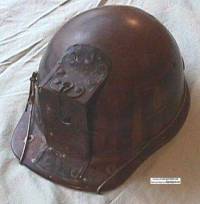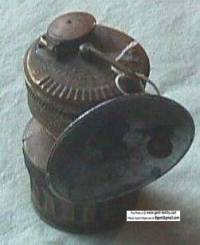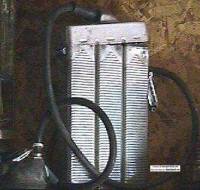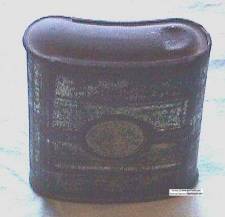
Mine Memorabilia
Bienfait, Saskatchewan, Canada
A Few more Pictures of Equipment used in the Underground Coal Mines, in and near Bienfait and Estevan Sask. All of these items were saved by my dad, Phil Gent, a honorary Lignite Louie. I am the proud holder of these items. And they will be passed down to the next generation, as a reminder we not all had safe office jobs!
Underground Coal Mining was one of the most dangerous jobs known to man, and still today! It kills many miners, even with all the latest safety equipment.
My Dad's First Miner's Hat
Cloth, with hard brim, C/W Carbide Lamp holder this picture shows the Guys Dropper Carbide Lamp attached. Mixing Carbide with water droplets would produce the gas which would burn at the front of the hat. Very dangerous in underground mining due to the open flame. After these lamps were used, they switched to battery packs see below…
Next came the huge advancement called the Wood Hard Hat.
These were the first produced and were made out of Wood chips, glued into a mold, then varnished. They also had the Carbide lamp holder on the front, shown here without the lamp
Here is a close-up of the Guys Dropper Carbide Lamp
Bottom half would unscrew and the carbide would be inserted in there, Top half held the water, which was controlled by the small lever on the top, with notches to hold it in a certain position. On the side of the Lamp Lens is a small flint striker, that supplied the spark to ignite the gas
Aluminum Battery Pack
Worn on the belt with a rubber electric cord running to a small electric lamp holder, that attached to the front of the hard hats as the Carbide Lamps did. These were 100% safer, since no open flame.
Below are an assortment of Little Metal Tins with various uses, used underground
If you know of the proper use of these tins. please email me
Ask and I receive, from Mr Jimmy Brown, who at one time worked on my Grandparents farm,
and whose father worked at Western Dominion and M&S mines
Here is what he says about the tins above
“I believe that the centre tin (the one with the curved spout )
was used to fill a sweet oil lamp.This was a lamp used by miners in Scotland
and was mounted on the miners cap, much like the carbide lamp.
It had a spout with a round wick. It was filled thru a small hole near the top.
I don't know what sweet oil is but think it may have been whale oil.
It would burn with kerosene, but smoked very bad so was not officially allowed.
It was not used in the larger mines but may have been used in the small mines.
The larger tin looks like a black powder scoop.
And this possible solution for the middle tin, comes from Dr. Alan Moore, from Northampton, UK,
(The middle tin) could also be a priming tin for a incandescent vapour pressure lantern,
such as Primus or Petromax. These kerosene lamps had to be preheated
with a clean burning fuel as part of the lighting procedure.
The tin contained methylated spirit or denatured alcohol, and the curved tube allowed the right amount
of meths to be added to a small dish inside the glass, through a small hole in the base plate
while keeping the lantern upright. The dish could then be ignited using a match poked through the same hole.
When hot, the main valve would be opened and the lamp would light up.
The heat of the mantle then kept the whole thing hot.
These lamps would probably not have been used down the mine as they gulp oxygen,
but almost certainly they would be very useful on the surface
- in fact Tilley manufactured a mine shaft lamp with a downward facing reflector,
it could be suspended over the shaft to throw light down.
Tilley never used these meths filler cans
- they had a different system where an asbestos torch dipped in meths could be clipped to the burner tube.
They were in popular use from the 1920s onwards.
Now we have 2 choices on it's use.

Wolf Safety Lamp
Used underground and originally had a glass lens so the flame was not open to the Air.
This was still not as safe as a battery lamp.
This example is missing the glass lens, and is a little dented here and there, definitely showing it was used.
These were hung from the underground room roof to illuminate a larger area, than the small hat lamp.
They used a Room and Pillar form of mining, until 1942, The coal seam was accessed by a main slope or shaft.
The coal was then mined along a series of roadways that intersected at right angles, leaving pillars of coal
at the intersection to support the roof. The “Rooms” created varied in width from about 12 to 20 feet
and were the main source of coal output.
Since my Dad looked after the horses underground he would have used this lamp in the “Room”
where they were kept when not working.
After 1942, Strip mining was used in most mines.
This involved removing the overburden exposing the coal seam, and no risk of cave-ins etc.
Huge machines were required for this method. This method is still used today.
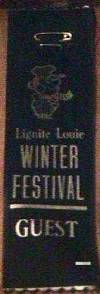
Lignite Louie Ribbon
Given to my Dad Phil Gent, when he was given the title of a Honorary Lignite Louie.
©

